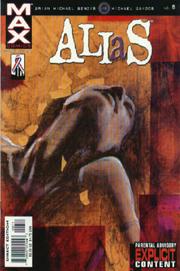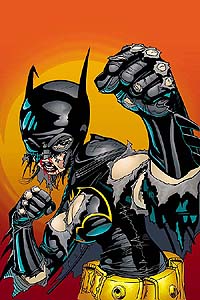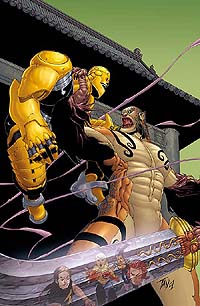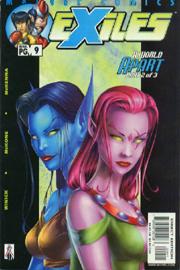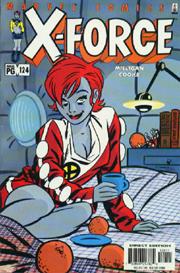|
Each week we take a critical look at some of the best books on the stands, courtesy of Big Guy's Comics (the unofficial comic book store of FanboyPlanet.com). If you publish a book that you want us to be covering, contact us. Or contact Derek. He doesn't have enough to do.
Hey Kids! Comics!
Alias #6
writer: Brian Michael Bendis, artist: Michael GaydosAfter averting a political scandal with Captain America, it's only fair that Jessica Jones gets to have a little down time. For the first time, we also get to see her actually seeming to enjoy it.
Just for the heck of it, Bendis also gets a shot in at Spider-Man, having Jessica voice a question that has to have crossed every fan's mind. As a bridge between major story arcs, this issue feels light. We've seen Jessica scared, determined, and somewhat bitter. Now Bendis gives us a woman we might like hanging around.
This MAX book also inhabits a reality in which secret identities are far less of a concern than in ours. Jessica knows that the fledgling Spider-Man was still a teen-ager, an element that doesn't often get commented upon. And a young would-be suitor easily tracks her down, due to his own "cape" obsession. (Echoed by Luke Cage - a character bit that will not please those Cage purists. Are there any besides Tony Isabella?)
With this issue, it looks likely that this book will be worth reading for the long haul, rather than being a clever mini-series idea gone out of control. At the very least, it bodes well that the originating team remains, not like last week's execrable extension of The Punisher.
Rating:

The Amazing Spider-Man #38
The Conversation
writer: J. Michael Straczynski, artists: John Romita, Jr. and Scott HannaNo super-villain threatens the city. No financial problems plague Peter. Aunt May even seems to be in reasonably good health. And yet Peter Parker faces the moment he hoped he never would.
Thank heavens that JMS is the one writing it.
Put aside that a similar plot turn was mishandled years ago during "The Clone Saga." (What plot turn wasn't?) This time the real Aunt May confronts Peter with his secret, with compelling results. Their conversation feels real, and if the consequences are to be expected, at least the readers' intelligence wasn't insulted.
In some ways, this is a throwback to the dynamic originally set by Lee and Ditko, which lapsed into near-parody over the last thirty years or so. Yes, May is old, and with that comes fragility. But time and time again writers forget that she has a strong spirit, and in the end that's what counts.
Don't come looking for action. Instead, this is thought-provoking, a little heart-warming, and revealing. May lets Peter in on a secret of her own that may truly alter Spider-Man, or at least let him grow up a little.
The art team doesn't take this issue to slack, either. Every panel ripples with emotion, culminating in a very effective final two pages. It's still annoying we had to wait two issues for this, but it was worth it.
Rating:

Batgirl #25
I Am Become Death, The Destroyer of Worlds
writer: Kelley Puckett, artists: Damion Scott and Robert CampanellaThis issue brings the emotional subplots to the fore. Though the nature of Batgirl and Barbara's relationship has been obvious, it's nice to see it stated outright. And it is time to get past that murder in the young heroine's past. (Not the responsibility as a result, but it seemed like a forced guilt. It's too easy for bat-family to use atonement as their motivation.)
A year has past since Batgirl confronted Shiva, which means that now they must fight to the death. Along the way Puckett reminds us of what makes this Batgirl unique, as she has regained much of her "body-reading" skill.
When she finally confronts Lady Shiva, the results will not be as expected. From this story, not one but two characters will be redefined. And my interest has been renewed.
The fight scenes have a better clarity than usual for this book. It helps to have them happen in the light, I guess. But Scott's faces still leave a lot to be desired. From the neck up, Shiva and Batgirl could pass as sisters. (And in fact, it wouldn't have been surprising to find out that they were mother/daughter from the artwork.) Thank heavens Barbara wears glasses and sits in a wheelchair, or we'd never know it was her.
Rating:

Doom Patrol #5
Fade writer: John Arcudi, artist: Tan Eng HuatThe two Doom Patrols team up to defeat a whole bunch of Chinese ghost-demons. Ho hum. This isn't so much about the cleverness of the fights or the solution to the mystery involved, as it's pretty obvious.
Instead, what makes this work (when it works) is that Arcudi and Huat have some of the freakiest heroes in the DC Universe to play with, and they have fun with the chance. Huat has a unique take on Robotman, and there's something interestingly textural about his Beast Boy. Perhaps this jade warrior really is jade?
The interaction amongst them all shows promise, but at the cost of consistency for some. Ralph Dibny should have figured this one out; Arcudi forgets that he has a reputation as a detective, not a stretchy fool. But he would have problems with the new Negative Man.
This book has the potential to be more than filler, but right now the most interesting question remains how Metamorpho came back to life. At the end, there's enough of a cliff-hanger to draw me into number 6, but admittedly, X-Men does the outcast hero thing better for a quarter less. Please, guys, make me care more. I want to.
Rating:

Exiles #9
A World Apart, part two
writer: Judd Winick, artists: Mike McKone and Mark McKennaFor those who thought that the Exiles were here to defeat the Skrulls, think again. You forgot a cardinal rule of Marveldom: when doing an alternate universe series, Galactus had better appear sooner than later.
In some ways, though, Winick makes it more sensible here than usual. As cool as the original "Galactus Trilogy" is, in fact, it has always bothered me that only The Fantastic Four were involved. On this Earth there is no Fantastic Four, though the individual heroes still exist. And what seemed to just be an excuse to show a parade of alternate takes on well-known characters has become something different.
Through it all Winick manages to retain the essence of the heroes, even though he doesn't have much time. This Reed Richards proves that he can be insufferable in explaining his technology no matter the universe or the actual lack of sophistication. When faced with a twisted Captain America, Mimic quickly proves his cleverness and nobility. In a strange way, he's more humble than the original Marvel Universe Mimic, who had little respect for other heroes.
And it's all wrapped up in great art from McKone and McKenna. If they're not fan favorites yet, they will be. This is some great stuff.
Rating:

The First #16
writer: Barbara Kesel, artists: Andrea Di Vito and Rob Hunter
reviewed by Charlie WentlingFor the second month in a row, The First has a fairly linear story. Last month the focus was on Pyrem, and this time out it is on his daughter Persha. More than any of the other characters, Persha is the one that the reader is supposed to identify with. She is one of the few who sees the big picture and wants what is best for everyone.
Persha came away with Altwaal's gauntlet after the conflict last month. The gauntlet has the power to amplify the natural abilities of whoever is wearing it. Persha uses the gauntlet to increase her ability to see through the eyes of others. She eavesdrops on all the other key players, including the captive Pyrem.
Not as much action takes place, but this issue continues on the high streak that the book has been on lately. Though this series took more than a year to really get going, all the groundwork that Barbara Kesel laid down is starting to pay off.
Rating:

Fury #6
The Man Who Loved War
writer: Garth Ennis, artists: Darick Robertson and Jimmy PalmiottiAs usual, we get a lot of carnage, well-drawn by Robertson and Palmiotti, though too much of it in close-up. Fury and Gagarin face off, F***face buys the farm, and everything goes to hell in a handbasket.
Which would be fine, if Ennis didn't want to have his cake and eat it, too. The first half of the book gets devoted to the aforementioned war (what's it about? At this point, it doesn't matter, having transcended whatever feeble excuse Gagarin had originally.), then shifts to Fury's homecoming.
And there we get the moral, except that we saw that one coming back in issue 1.
This series started off being fun, with Ennis' signature over-the-top style kind of novel when applied to Fury. But as he tried to get more serious, the wacky elements got more and more out of place. Fury's ward has gone from being funny to just pathetic, and the state of S.H.I.E.L.D. just seems too real.
Maybe that was the intent, but it adds up to not just a downer, but a clichéd anti-climax. If you've bought the series so far, you have to finish it. But for those waiting for the trade paperback, if you must read it, borrow it from your local library.
Rating:

Green Lantern #147
Standing Up
writer: Judd Winick, artists: Dale Eaglesham and Rodney RamosA few issues back, Fatality intimated that John Stewart's physical problems were all in his mind. Finally, enough hullabaloo over Kyle's transformation into Ion has subsided for Winick to get back to that.
Despite the eye-catching cover, Stewart isn't a prisoner of the lantern. The only one tormenting him is, of course, himself, and this issue takes him through therapy. While the hypnotism angle may seem hokey, Winick uses the hoary device to define John Stewart, a character he obviously loves. And in his hands, fans may get to love him again, too.
Winick addresses some of the seeming contradictions in Stewart's character, from the angry black man who first appeared to the competent Darkstar leader and now semi-mentor to Kyle. Though he does drop a few elements of his past (no mention of his romance with Katma Tui, of which current love Merayne is just a rehash), that's okay. We need to know who John Stewart is more than we need to know who he was. If only Winick could get rid of that whole genocide thing.
Next month will return to focusing on Ion, but it's good to take a break and pay attention to other Lanterns. There may not be a corps per se but Winick has plenty of heroes left who fit under the book's title. Right now, the only one actually called Green Lantern is a woman.
Rating:

Mystic #21
writer: Tony Bedard, artists: Fabrizio Fiorentino and Matt Ryan
reviewed by: Charlie WentlingTony Bedard changes the pace this month. Giselle's second battle with Animora ended last issue with an apparent victory. However, we see right away that Animora is only weakened but not defeated, and everything that happened was part of her plan. Animora sneaks off with Darrow to return again at some future date.
The fight has had an impact on Giselle. She abandons the responsibility that she had started feeling since gaining her sigil and goes back to her old party-girl ways. Skitter is concerned, recruiting Thierry to snap Giselle out of her funk.
A new character, police detective Manion, is introduced. He is a classic corrupt cop and will undoubtedly come into conflict with Giselle in the future. Bedard does a good job at showing what life would be like on a world where magic is commonplace. The dark humor works too. On this world instead of PETA, we have PETF (People for the Ethical Treatment of Fairy-Folk).
New artist Fabrizio Fiorentino does a nice job. This issue was better than the fill-in that he did a few months back. If the rate of improvement continues, it won't be long before Brandon Peterson isn't missed.
Rating:

Superman #179
What Can One Icon Do?
writers: Jeph Loeb and Geoff Johns, artist: Ariel OlivettiThis issue is tough to review. Even as Superman is forced to examine his own values after encountering new hero Muhammad X, the reader faces the same problems. Though the story seems to reach one conclusion for me, I'm sure there will be many readers who take away exactly the opposite. So, like many dialogues on race issues, this review will probably end up awkward, a little vague but well-meaning, just like Superman #179.
After another therapy session, Superman stops a crime in Harlem. No, it has nothing to do with Clinton. But the bigger issue lies in everyone's reaction to it. As Muhammad X puts it, "Superman doesn't come to Harlem."
The ensuing war of words between the two heroes puts Superman in a funk. Back at Steel's headquarters, the man of steel polls Natasha and Courtney as to who they look up to as superhero role models. Naturally, Natasha puts her uncle at the top of the list, but then mentions a bunch of minority super-heroes (and I have no idea if any of them have actually "appeared" before this). Courtney says Superman is her hero. And he's disturbed by the whole black and white split.
Praise should go to Loeb (with help from Geoff Johns) on tackling this issue, another in a litany of introspective stories from the writer on just what meaning Superman has in today's culture. Unfortunately, Superman comes off awkwardly; the deeper issues really get glossed over in favor of a quick one-issue wrap-up. It shouldn't be enough for Superman to say "why, some of my best friends are black…" in defense to Muhammad X. Instead, examine why that phrase carries so much ambiguity in national debate.
Maybe that's the plan, and Johns and Loeb will write a one-shot or mini-series elsewhere exploring the issues more deeply. If the heroes Natasha mentions really have not appeared elsewhere, than it demonstrates that DC could use a little more diversity in its line-up. As long as it sells, of course.
Olivetti's artwork is, as to be expected, really, really nice. The biggest complaint lies in character design: Muhammad X looks almost exactly like John Stewart did in the Justice League cartoon, and both of them look like they're trying to do Wesley Snipes as Blade. And so the guy feels clichéd before he even opens his mouth; it doesn't really help balance the argument.
Or maybe I'm just jumping to a conclusion. See? It's tricky.
Rating:

Ultimate Spider-Man #18
writer: Brian Michael Bendis, artists: Mark Bagley and Art ThibertJust like his predecessor in 1961, Ultimate Doctor Octopus has amazing telepathic control over his cybernetic arms after such a short time melded to them. At least Bendis has made them cooler, with a slightly amorphous quality to them.
The fight that takes up the first half has a rough quality to it, which is a nice touch. Bagley and Thibert underscore this by really bringing out the lack of grace in Peter. As Ditko did all those years ago, they depict a guy who achieves impossible moves and angles as a result of his mutation. He does what's expedient in a fight, not anything calculated. Later, Mary Jane even suggests he take a class in martial arts. As strong as Spider-Man is, he can still get his butt kicked because he really doesn't know how to fight.
He does know how to mouth off, though, and Bendis has given him some good zingers, if appropriately immature.
I still can't make my mind up if it's logical that Peter's secret identity should be so fragile a secret, though. Bendis leaves Peter in another tight spot, "about to be discovered," and it feels like that's a well he's already gone to too often in so short a run.
Rating:

X-Force #124
Edie and Guy Finally Do It
writer: Peter Milligan, artist: Darwyn CookeBecause the book has maintained a PG rating, you can calm down about the story title. Eventually the two characters do get down to it, but in an old-style, cutaway to the train in the station kind of way.
Instead, the book focuses on U-Go Girl's past. A few issues ago she had accidentally teleported the team to her childhood home before fleeing, and this story begins with her out of control yet again. Guy gives her a week to regain control over her abilities, or she's out.
And so the two trek out to a desert hotel to sort out their feelings and the forces that shaped Edie's life. The answers are a little more thoughtful than this book has delivered before, and it's an interesting change.
Darwyn Cooke does a great job filling in for Mike Allred. Their styles have a similar enough tone that the substitution isn't jarring (Allred actually inks Cooke over on Catwoman), but Cooke does have a different spin. There's something more simplistic about it, as if designed for animation. Whatever. If Allred needs him to fill in again, this won't be a bad thing.
If you're still not buying this book out of protest for the rape of Rob Liefeld's original concept, get over it. You're missing out big-time.
Rating:

For alternate views and more books, check out Daryl Tay's site, Unique Frequencies.

All comics were reviewed by Derek McCaw unless otherwise noted.













